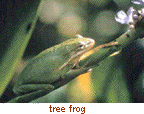Animal or Plant?
This Lesson developed by Reach Out!
Recommended Age Groups: Early Elementary

- What is a living thing?
- What is an animal?
- What is a plant?
Objectives
- Something that is alive has life! It is not an object and it is not dead.
- Animals are living things that can move around, eat food for fuel, and reproduce.
- Plants are living things that usually make their own food, reproduce, but cannot move around.
- Most plants make their own food by a process called photosynthesis.
- All green plants make their own food because they have a substance in them called chlorophyll. Chlorophyll is a key part of the process of photosynthesis.
- Photosynthesis is the process by which plants use sunlight to produce the food they need to live and grow.
Principles:
- All living things have to have food for fuel and energy.
- Animals and plants are different because animals cannot produce their own food; plants can produce their own food.
- Animals and plants are different because animals can move around; plants cannot move around from one place to another.
Skills
- Making Observations
- Making Comparisons
- Communicating Findings
- Making Inferences
- Drawing Conclusions
Materials:
- Large pieces of drawing paper
- Pencils, crayons, magic markers
- May take something stiff to put paper on while drawing
- Outdoors area with many critters and plants
Room Preparation
None—Going Outdoors!
Safety Precautions
Dress appropriately for the weather. May need insect repellant.
Procedures and Activity
Introduction
Ask the guiding questions:
- What is a living thing?
Share examples of living and non-living things. Help children see that all living things are "alive"—they aren’t dead but will die someday. All living things grow, need food, and reproduce.
- What is an animal?
Share examples of animals. Help children see that animals have to eat, but they cannot produce their own food. They eat other animals and plants. Most animals can move around from one place to another. Animals don’t all get around in the same way. Some run, while others walk, creep, fly, or hop.
- What is a plant?
Discuss examples of plants. Then think about what makes all these plants alike or similar. For example, plants all grow and need air, usually dirt or soil, water, and sunlight. Plants can produce other plants like themselves.
Many plants are green. Share the idea of plants using photosynthesis as a way to make food by turning sunlight into fuel and energy. Add that most plants can’t move around and get from one place to another.
Activity
- Continue the discussion to figure out how plants and animals are different. Help them come to some understandings such as that plants can make their own food; animals cannot. Animals can move around from place to place; plants cannot.
- Today, we are going on a walk to be scientists and investigators. We are going to look for examples of plants and animals. There are lots and lots of them around us every day, but most of the time we don’t look for them!
- Pass out drawing paper. Have them fold the paper in half and then unfold paper. Draw a line down the middle of the paper.
- On the right hand side, write the word “animals” at the top.
- On the left hand side, write the word “plants” at the top.
- Explain that they are to identify the plants and animals they find on our walk. They may use words, pictures, or both.
- Go on walk and let children observe, identify, classify and record information. Remind them that these skills are what scientists use every day.
Evaluation
Closing - Original Question
Back in the classroom, ask again:
- What is a living thing?
- What is an animal?
- What is a plant?
Listen as children share examples of plants and animals. Have them offer explanations for why they classified different things the way they did. Encourage them to define characteristics of all living things and then of plants and animals.
Extension Ideas
- This lessson is a neat springboard for children picking out specific plants or animals they are interested in to research and learn more about! Help them use the Web, books, movies, and encyclopedias to gather more information about plants or animals. Have them share what they learn with others via a story, presentation, drawing, or paper.
- Some may want to learn more about photosynthesis. Let them explore the wide range of plants that there are. Look for examples of plants that can move around or that “eat” for nourishment like the carnivorous plants!
- Check out the University of Michigan’s Museum of Zoology’s Animal Diversity Web to see pictures and information about many animals.
- Explore Energy Flow in Amazonia. How do plants, animals, and other organisms obtain the energy they need to live? What does an enery pyramid demonstrate about how energy is used in an ecosystem? This project helps students, grades 6-9, understand these concepts as they construct a World Wide Web energy pyramid. Students may also research an Amazonian organism of their choice.
- Explore and enjoy photos, information, and even sounds of hundreds of animals in the fascinating Animal Bytes database from Sea World

Walang komento:
Mag-post ng isang Komento